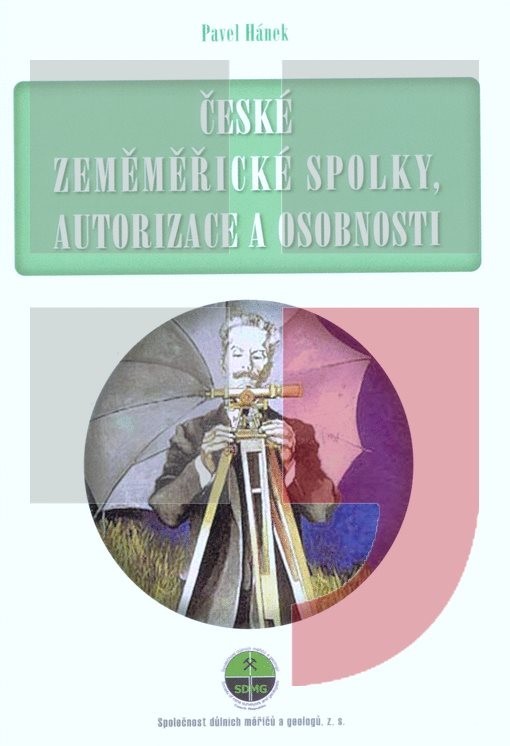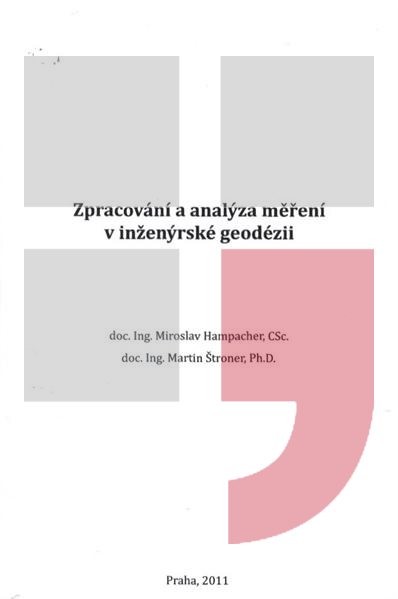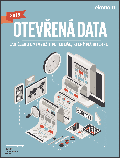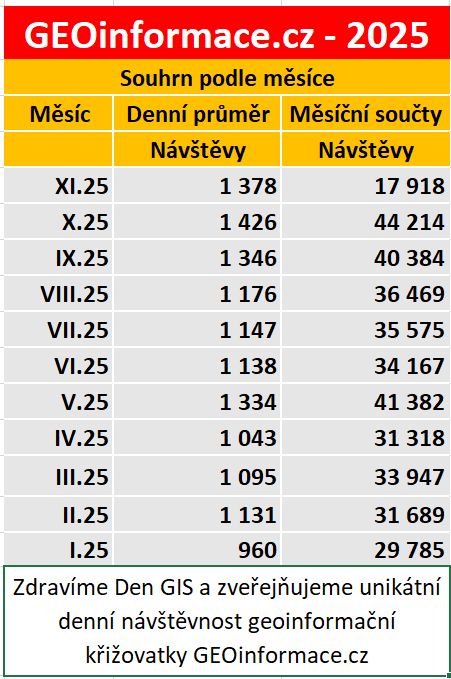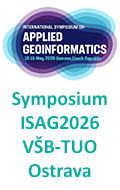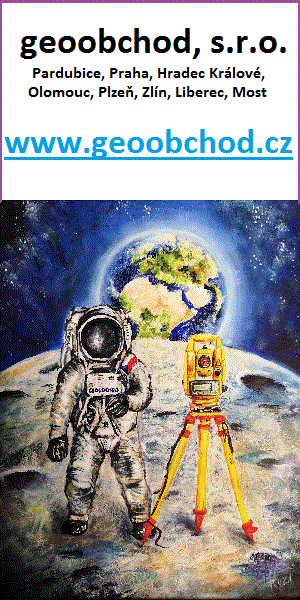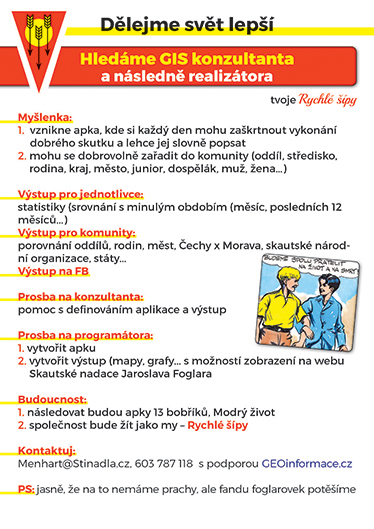zprávy
zdroje zpráv:Geograf/ka EX ID 90000345
27.11.2025 12:20 ČÚZK /Urady/Zememericky-urad/Uredni-deska/Oznameni-a-jina-uredni-sdeleni/Volna-mista/DMS/Geograf-ka-EX-ID-90000345Geograf/ka EX ID 90000345
27.11.2025 12:20 Zeměměřický úřad Zeměměřický úřadvypisuje výběrové řízení na místo
Geograf/ka EX ID 90000345
Geograf/ka EX ID 90000345
27.11.2025 12:20 ČÚZK - volná místa Zeměměřický úřad vypisuje výběrové řízení na místo Geograf/ka EX ID 90000345Geograf/ka EX ID 90000345
27.11.2025 12:20 ČÚZK - předpisy a opatření Zeměměřický úřadvypisuje výběrové řízení na místo
Geograf/ka EX ID 90000345
ESA and Norway explore possibility of Arctic Space Centre
27.11.2025 8:35 ESA Observing the Earth
The European Space Agency has signed a letter of intent with Norway to advance the prospect of a new ESA Arctic Space Centre to be hosted in Tromsø.
ESA and Norway explore possibility of Arctic Space Centre
27.11.2025 8:35 ESA Observing the Earth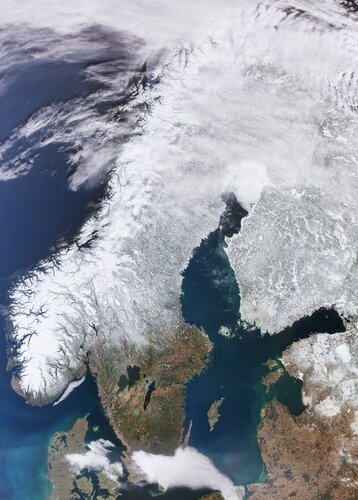
The European Space Agency has signed a letter of intent with Norway to advance the prospect of a new ESA Arctic Space Centre to be hosted in Tromsø.
Privacy Policy for Satsurv App
27.11.2025 4:36 Satlab GeosolutionsEffective Date: January 1, 2025 This Privacy Policy describes how the Satsurv mobile application (“the App”) collects, […]
The post Privacy Policy for Satsurv App appeared first on Global Satellite Positioning Solutions | SatLab Geosolutions AB.
Aktualizácia firmvérov a softvérov v rámci programu TRIMBLE PROTECTED PLAN
26.11.2025 20:36 Geotronics.sk Čo je to Trimble Protected Plan (TPP)? Ide o nadštandardnú službu poskytovanú zákazníkom, ktorý vlastnia zariadenia značky Trimble (totálne stanice, GNSS prijímače, kontrolné jednotky, nivelačné prístroje, 3D laserové skenery, terénne a kancelárske softvéry) a chcú ich chrániť pred neočakávanými udalosťami, rizikami. Tie totiž každodenná práca v oblasti stavebníctva, geodézie alebo iných technických [...]Klima, doprava, povolování staveb. Pražský 3D model a jeho využití
26.11.2025 20:14 BIM NewsJiří Čtyroký z Institutu plánování a rozvoje hl. m. Prahy (IPR) představil na semináři sdružení Nemoforum koncept pražského Digitálního modelu vystavěného prostředí. Nejedná se pouze o 3D vizualizaci, ale o komplexní systém směřující k vytvoření tzv. digitálního dvojčete města. Model integruje geometrická data s informacemi o vlastnostech, identifikaci a chování objektů. Obsah a standardy Technickým základem je standard CityGML 3.0. Zatímco základní model obsahuje budovy […]
The post Klima, doprava, povolování staveb. Pražský 3D model a jeho využití appeared first on Zeměměřič.
Co je Základní model vystavěného prostředí (ZMVP). Zeměměřický úřad vytváří 3D model republiky
26.11.2025 19:34 BIM NewsProjekt vytvoření Základního modelu vystavěného prostředí ČR (ZMVP), jehož gestorem a správcem je Zeměměřický úřad, vzniká v reakci na digitalizaci státní správy a nové legislativní požadavky, konkrétně nový stavební zákon a zákon o správě informací o stavbě (tzv. zákon o BIM). Cílem je vytvořit státem garantovaný, jednotný 3D model území České republiky, který propojí svět geografických dat (GIS) s informačním modelováním staveb (BIM). Technické […]
The post Co je Základní model vystavěného prostředí (ZMVP). Zeměměřický úřad vytváří 3D model republiky appeared first on Zeměměřič.
Watch: HydroGNSS, IRIDE and Greek mission satellites launch
26.11.2025 17:50 ESA Observing the Earth
Update 26 November: The launch is now targeted for 28 November.
The European Space Agency’s HydroGNSS, a twin-satellite mission to gather data on Earth’s water cycle, is now scheduled to launch on 28 November at 19:44 CET (10:44 Pacific Time). Live coverage of the launch will be shown on ESA Web TV.
Watch: HydroGNSS, IRIDE and Greek mission satellites launch
26.11.2025 17:50 ESA Observing the Earth
Update 26 November: The launch is now targeted for 28 November.
The European Space Agency’s HydroGNSS, a twin-satellite mission to gather data on Earth’s water cycle, is now scheduled to launch on 28 November at 19:18 CET (10:18 Pacific Time). Live coverage of the launch will be shown on ESA Web TV.
Sentinel-5 debuts images of atmospheric gases
26.11.2025 16:35 ESA Observing the Earth
Launched just a little over three months ago, Copernicus Sentinel-5A has returned its first images – including a global map of ozone, maps of nitrogen dioxide over the Middle East and South Africa, formaldehyde over parts of Africa, and emissions of sulphur dioxide from an active volcano in Russia – showcasing the mission’s powerful capability to monitor atmospheric gases worldwide.
Sentinel-1D delivers first images: from Antarctica to Bremen
26.11.2025 16:30 ESA Observing the Earth
The first high-resolution images have been received from Copernicus Sentinel-1D and were shared publicly for the first time at the European Space Agency’s Ministerial Council, held today in Bremen, Germany. Glaciers in Antarctica, the tip of South America, as well as the city of Bremen, are visible in these stunning radar images.
Vedoucí oddělení metodiky a kontroly
26.11.2025 15:59 ČÚZK - volná místa Katastrální úřad pro Středočeský kraj vypisuje výběrové řízení na místo Vedoucí oddělení metodiky a kontrolyVedoucí oddělení metodiky a kontroly
26.11.2025 15:59 ČÚZK /Urady/Katastralni-urady/Katastralni-urady/Katastralni-urad-pro-Stredocesky-kraj/Uredni-deska/Oznameni-a-jina-uredni-sdeleni/Volna-mista/DMS/Vedouci-oddeleni-metodiky-a-kontrolyVedoucí oddělení metodiky a kontroly
26.11.2025 15:59 ČÚZK - předpisy a opatření Katastrální úřad pro Středočeský krajvypisuje výběrové řízení na místo
Vedoucí oddělení metodiky a kontroly
Krátkodobé výpadky elektronických služieb
26.11.2025 15:37
ÚGKK SR
Dňa 26.11.2025 /streda/ v čase od 18:00 hod. do 20:00 hod., bude realizovaná plánovaná údržba zariadení rezortu.
Z uvedeného dôvodu a v uvedenom čase môže dochádzať k výpadkom elektronických služieb.
Za vzniknuté problémy s nedostupnosťou služieb sa ospravedlňujeme.
#PortálESKN #od:26.11.2025@18:00 #do:26.11.2025@20:00
Rada oddělení aktualizace KN
26.11.2025 15:16 ČÚZK - volná místa Katastrální úřad pro Středočeský kraj - Katastrální pracoviště Příbram vypisuje výběrové řízení na místo Rada oddělení aktualizace KNRada oddělení aktualizace KN
26.11.2025 15:16 ČÚZK - předpisy a opatření Katastrální úřad pro Středočeský kraj - Katastrální pracoviště Příbramvypisuje výběrové řízení na místo
Rada oddělení aktualizace KN
rada – rozhodování o povolení vkladu práv k nemovitostem do KN
26.11.2025 14:37 ČÚZK /Urady/Katastralni-urady/Katastralni-urady/Katastralni-urad-pro-hlavni-mesto-Prahu/O-uradu/Aktuality/rada-–-rozhodovani-o-povoleni-vkladu-prav-k-ne-(2)rada – rozhodování o povolení vkladu práv k nemovitostem do KN
26.11.2025 14:37 ČÚZK - předpisy a opatření Katastrální úřad pro hlavní město Prahu zveřejnil novou aktualitu: Ředitelka úřadu vyhlašuje výběrové řízení na pozici:rada – rozhodování o povolení vkladu práv k nemovitostem do KN
rada – rozhodování o povolení vkladu práv k nemovitostem do KN
26.11.2025 14:36 ČÚZK /Urady/Katastralni-urady/Katastralni-urady/Katastralni-urad-pro-hlavni-mesto-Prahu/Uredni-deska/Oznameni-a-jina-uredni-sdeleni/Volna-mista/rada-–-rozhodovani-o-povoleni-vkladu-prav-k-ne-(2)rada – rozhodování o povolení vkladu práv k nemovitostem do KN
26.11.2025 14:36 ČÚZK - předpisy a opatření Katastrální úřad pro hlavní město Prahuvypisuje výběrové řízení na místo
rada – rozhodování o povolení vkladu práv k nemovitostem do KN
rada – rozhodování o povolení vkladu práv k nemovitostem do KN
26.11.2025 14:36 ČÚZK - volná místa Katastrální úřad pro hlavní město Prahu vypisuje výběrové řízení na místo rada – rozhodování o povolení vkladu práv k nemovitostem do KNrada – vedení katastrální mapy, řízení o údajích SGI
26.11.2025 14:35 ČÚZK - předpisy a opatření Katastrální úřad pro hlavní město Prahu zveřejnil novou aktualitu: Ředitelka úřadu vyhlašuje výběrové řízení na pozici:rada – vedení katastrální mapy, řízení o údajích SGI
rada – vedení katastrální mapy, řízení o údajích SGI
26.11.2025 14:35 ČÚZK /Urady/Katastralni-urady/Katastralni-urady/Katastralni-urad-pro-hlavni-mesto-Prahu/O-uradu/Aktuality/rada-–-vedeni-katastralni-mapy,-rizeni-o-udajich-Srada – vedení katastrální mapy, řízení o údajích SGI
26.11.2025 14:34 ČÚZK /Urady/Katastralni-urady/Katastralni-urady/Katastralni-urad-pro-hlavni-mesto-Prahu/Uredni-deska/Oznameni-a-jina-uredni-sdeleni/Volna-mista/rada-–-vedeni-katastralni-mapy,-rizeni-o-udajich-Srada – vedení katastrální mapy, řízení o údajích SGI
26.11.2025 14:34 ČÚZK - volná místa Katastrální úřad pro hlavní město Prahu vypisuje výběrové řízení na místo rada – vedení katastrální mapy, řízení o údajích SGIrada – vedení katastrální mapy, řízení o údajích SGI
26.11.2025 14:34 ČÚZK - předpisy a opatření Katastrální úřad pro hlavní město Prahuvypisuje výběrové řízení na místo
rada – vedení katastrální mapy, řízení o údajích SGI
Rozhodování o povolení vkladu v oddělení právních vztahů k nemovitostem Katastrálního pracoviště Val
26.11.2025 14:20 ČÚZK - volná místa Katastrální úřad pro Zlínský kraj Katastrální pracoviště Valašské Klobouky vypisuje výběrové řízení na místo Rozhodování o povolení vkladu v oddělení právních vztahů k nemovitostem Katastrálního pracoviště ValRozhodování o povolení vkladu v oddělení právních vztahů k nemovitostem Katastrálního pracoviště Val
26.11.2025 14:20 ČÚZK /Urady/Katastralni-urady/Katastralni-urady/Katastralni-urad-pro-Zlinsky-kraj/Uredni-deska/Oznameni-a-jina-uredni-sdeleni/Volna-mista/DMS/Rozhodovani-o-povoleni-vkladu-v-oddeleni-pravnich-Rozhodování o povolení vkladu v oddělení právních vztahů k nemovitostem Katastrálního pracoviště Val
26.11.2025 14:20 ČÚZK - předpisy a opatření Katastrální úřad pro Zlínský kraj Katastrální pracoviště Valašské Kloboukyvypisuje výběrové řízení na místo
Rozhodování o povolení vkladu v oddělení právních vztahů k nemovitostem Katastrálního pracoviště Valašské Klobouky
Jak se měnila Olomouc během čtyř staletí?
26.11.2025 12:13 Katedra geoinformatiky UP OlomoucNová webová mapová aplikace „Proměny Olomouce v čase“ nabízí unikátní pohled na vývoj města – od barokních bastionů až po současnou Olomouc. Na více než 70 mapových vrstvách si můžete porovnat historické plány ze 17. století, vojenská mapování, územní plány i nejnovější ortofota. Díky tomu lze sledovat, jak se měnila městská zástavba, krajina nebo dopravní […]
The post Jak se měnila Olomouc během čtyř staletí? first appeared on Katedra geoinformatiky.
Výběrové řízení
26.11.2025 11:46 ČÚZK - předpisy a opatření Katastrální úřad pro Plzeňský kraj - Katastrální pracoviště Plzeň-město zveřejnil novou aktualitu: Oznámení o vyhlášení výběrového řízení na služební místo řízení o opravě chyby v SPI, ROCHSPI1003, oddělení aktualizace a dokumentace KN na Katastrálním pracovišti Plzeň - město.Výběrové řízení na služební místo řízení o opravě chyby v SPI
26.11.2025 11:40 ČÚZK - předpisy a opatření Katastrální úřad pro Plzeňský kraj Katastrální pracoviště Plzeň-městovypisuje výběrové řízení na místo
Výběrové řízení na služební místo řízení o opravě chyby v SPI
Výběrové řízení na služební místo řízení o opravě chyby v SPI
26.11.2025 11:40 ČÚZK /Urady/Katastralni-urady/Katastralni-urady/Katastralni-urad-pro-Plzensky-kraj/Uredni-deska/Oznameni-a-jina-uredni-sdeleni/Volna-mista/DMS/Vyberove-rizeni-na-sluzebni-misto-rizeni-o-oprave-Výběrové řízení na služební místo řízení o opravě chyby v SPI
26.11.2025 11:40 ČÚZK - volná místa Katastrální úřad pro Plzeňský kraj Katastrální pracoviště Plzeň-město vypisuje výběrové řízení na místo Výběrové řízení na služební místo řízení o opravě chyby v SPIGeograf – Fotogrammetr EX ID 90000352
26.11.2025 10:02 ČÚZK - volná místa Zeměměřický úřad vypisuje výběrové řízení na místo Geograf – Fotogrammetr EX ID 90000352Geograf – Fotogrammetr EX ID 90000352
26.11.2025 10:02 Zeměměřický úřad Zeměměřický úřadvypisuje výběrové řízení na místo
Geograf – Fotogrammetr EX ID 90000352
Geograf – Fotogrammetr EX ID 90000352
26.11.2025 10:02 ČÚZK - předpisy a opatření Zeměměřický úřadvypisuje výběrové řízení na místo
Geograf – Fotogrammetr EX ID 90000352
Geograf – Fotogrammetr EX ID 90000352
26.11.2025 10:02 ČÚZK /Urady/Zememericky-urad/Volna-mista/DMS/Geograf-–-Fotogrammetr-EX-ID-9000035220251125-VŘ Metodika účetnictví a rozpočtu
25.11.2025 17:17 ČÚZK - aktuality v resortu Oznámení o vyhlášení výběrového řízení na obsazení služebního místa Metodika účetnictví a rozpočtu.20251125-VŘ Metodika účetnictví a rozpočtu
25.11.2025 17:17 ČÚZK /Aktuality-resort/2025/20251125-VR-Metodika-ucetnictvi-a-rozpoctu20251125-VŘ Metodika účetnictví a rozpočtu
25.11.2025 17:17 ČÚZK - předpisy a opatření Český úřad zeměměřický a katastrální zveřejnil novou aktualitu: Oznámení o vyhlášení výběrového řízení na obsazení služebního místa Metodika účetnictví a rozpočtu.obnova katastrálního operátu v oddělení obnovy katastrálního operátu (3050) odboru obnovy katastráln
25.11.2025 17:07 ČÚZK /Urady/Katastralni-urady/Katastralni-urady/Katastralni-urad-pro-Jihocesky-kraj/Uredni-deska/Oznameni-a-jina-uredni-sdeleni/Volna-mista/DMS/obnova-katastralniho-operatu-v-oddeleni-obnovy-(1)obnova katastrálního operátu v oddělení obnovy katastrálního operátu (3050) odboru obnovy katastráln
25.11.2025 17:07 ČÚZK - volná místa Katastrální úřad pro Jihočeský kraj odbor obnovy katastrálního operátu vypisuje výběrové řízení na místo obnova katastrálního operátu v oddělení obnovy katastrálního operátu (3050) odboru obnovy katastrálnobnova katastrálního operátu v oddělení obnovy katastrálního operátu (3050) odboru obnovy katastráln
25.11.2025 17:07 ČÚZK - předpisy a opatření Katastrální úřad pro Jihočeský kraj odbor obnovy katastrálního operátuvypisuje výběrové řízení na místo
obnova katastrálního operátu v oddělení obnovy katastrálního operátu (3050) odboru obnovy katastrálního operátu na Katastrálním úřadu pro Jihočeský kraj
obnova katastrálního operátu v oddělení obnovy katastrálního operátu (3030) odboru obnovy katastráln
25.11.2025 16:43 ČÚZK /Urady/Katastralni-urady/Katastralni-urady/Katastralni-urad-pro-Jihocesky-kraj/Uredni-deska/Oznameni-a-jina-uredni-sdeleni/Volna-mista/DMS/obnova-katastralniho-operatu-v-oddeleni-obnovy-katobnova katastrálního operátu v oddělení obnovy katastrálního operátu (3030) odboru obnovy katastráln
25.11.2025 16:43 ČÚZK - předpisy a opatření Katastrální úřad pro Jihočeský kraj odbor obnovy katastrálního operátuvypisuje výběrové řízení na místo
obnova katastrálního operátu v oddělení obnovy katastrálního operátu (3030) odboru obnovy katastrálního operátu na Katastrálním úřadu pro Jihočeský kraj
obnova katastrálního operátu v oddělení obnovy katastrálního operátu (3030) odboru obnovy katastráln
25.11.2025 16:43 ČÚZK - volná místa Katastrální úřad pro Jihočeský kraj odbor obnovy katastrálního operátu vypisuje výběrové řízení na místo obnova katastrálního operátu v oddělení obnovy katastrálního operátu (3030) odboru obnovy katastrálnEthiopian volcanic plume
25.11.2025 11:52 ESA Observing the Earth Image:
The Hayli Gubbi volcano in northeast Ethiopia, dormant for up to 12 000 years, erupted on 23 November 2025, sending a large plume of ash and sulphur dioxide into the atmosphere. Copernicus Sentinel-5P captured the spread of the sulphur dioxide.
Image:
The Hayli Gubbi volcano in northeast Ethiopia, dormant for up to 12 000 years, erupted on 23 November 2025, sending a large plume of ash and sulphur dioxide into the atmosphere. Copernicus Sentinel-5P captured the spread of the sulphur dioxide.
Next MetOp Second Generation weather satellite in the spotlight
24.11.2025 11:32 ESA Observing the Earth
The MetOp Second Generation-B1 satellite has entered its third and most delicate round of pre-launch testing, marking another step towards strengthening Europe’s weather forecasting capabilities.
Engineers are now putting the satellite through rigorous electromagnetic compatibility tests to ensure that its many electronic systems can operate without interfering with one another once this new weather satellite is in orbit around Earth next year.
Oznámení o vyhlášení výběrového řízení
24.11.2025 10:20 ČÚZK - předpisy a opatření Katastrální úřad pro Plzeňský kraj - Katastrální pracoviště Plzeň-sever zveřejnil novou aktualitu: Oznámení o vyhlášení výběrového řízení na služební místo vedení katastrální mapy, VKM1103, oddělení aktualizace KN na Katastrálním pracovišti Plzeň - sever.Vyhlášení výběrového řízení na služební místo vedení katastrální mapy, VKM1103
24.11.2025 10:18 ČÚZK - předpisy a opatření Katastrální úřad pro Plzeňský kraj Katastrální pracoviště Plzeň-severvypisuje výběrové řízení na místo
Vyhlášení výběrového řízení na služební místo vedení katastrální mapy, VKM1103
Vyhlášení výběrového řízení na služební místo vedení katastrální mapy, VKM1103
24.11.2025 10:18 ČÚZK /Urady/Katastralni-urady/Katastralni-urady/Katastralni-urad-pro-Plzensky-kraj/Uredni-deska/Oznameni-a-jina-uredni-sdeleni/Volna-mista/DMS/Vyhlaseni-vyberoveho-rizeni-na-sluzebni-misto-vedeVyhlášení výběrového řízení na služební místo vedení katastrální mapy, VKM1103
24.11.2025 10:18 ČÚZK - volná místa Katastrální úřad pro Plzeňský kraj Katastrální pracoviště Plzeň-sever vypisuje výběrové řízení na místo Vyhlášení výběrového řízení na služební místo vedení katastrální mapy, VKM1103Mapová aplikace ÚPD - nové dokumentace
24.11.2025 10:10 Jihočeský krajV mapové aplikaci Územně plánovací dokumentace obcí byla aktualizována ÚPD obcí ORP Týn nad Vltavou - Hartmanice, ORP Tábor - Slapsko.
Rada oddělení aktualizace KN č.2 na Katastrálním pracovišti Znojmo
24.11.2025 9:23 ČÚZK /Urady/Katastralni-urady/Katastralni-urady/Katastralni-urad-pro-Jihomoravsky-kraj/Uredni-deska/Oznameni-a-jina-uredni-sdeleni/Volna-mista/DMS/Rada-oddeleni-aktualizace-KN-c-2-na-Katastralnim-pRada oddělení aktualizace KN č.2 na Katastrálním pracovišti Znojmo
24.11.2025 9:23 ČÚZK - volná místa Katastrální úřad pro Jihomoravský kraj Katastrální pracoviště Znojmo vypisuje výběrové řízení na místo Rada oddělení aktualizace KN č.2 na Katastrálním pracovišti ZnojmoRada oddělení aktualizace KN č.2 na Katastrálním pracovišti Znojmo
24.11.2025 9:23 ČÚZK - předpisy a opatření Katastrální úřad pro Jihomoravský kraj Katastrální pracoviště Znojmovypisuje výběrové řízení na místo
Rada oddělení aktualizace KN č.2 na Katastrálním pracovišti Znojmo
Pozemkové úpravy v praxi: Pobočka Děčín otevřela dveře studentům UJEP
24.11.2025 0:00 Státní pozemkový úřad V pátek 24. října 2025 se na děčínské pobočce Státního pozemkového úřadu (SPÚ) uskutečnila exkurze pro studenty Fakulty životního prostředí Univerzity Jana Evangelisty Purkyně v Ústí nad Labem. Více než 20 studentů mělo jedinečnou příležitost prozkoumat písemný elaborát komplexních pozemkových úprav, což jim poskytlo hlubší vhled do problematiky správy krajiny a plánování území.DAEX DESIGN Start 26 v akci
22.11.2025 14:40 ŠPINAR - software DAEX DESIGN Start s akčními bonusy do 28. 11. 2025! (LightWorks, DAEX Importér pro konfigurátor Blum a propojení na sortiment materiálů Démos).Kartografický příspěvek v rámci uvedení knihy Dějiny skalpování
22.11.2025 13:54 Česká kartografická společnostZveme zájemce o tvorbu map pro knižní publikace s netradičním odborným zaměřením na uvedení knihy Dějiny skalpování (Academia 2025), které se uskuteční v úterý 25. listopadu 2025 od 18:00 v Náprstkově muzeu, Betlémské náměstí 1, Praha. Pro knihu připravil mapy člen České kartografické společnosti Jan D. Bláha (Fakulta sociálních věd, Univerzita Karlova; UJEP v Ústí […]
The post Kartografický příspěvek v rámci uvedení knihy Dějiny skalpování first appeared on Česká kartografická společnost.
Nová éra bezpečnosti a efektivity na pracovisku s rozšírenou realitou
21.11.2025 10:00 Geotronics.sk Predstavte si situáciu, kedy stavebná skupina príde pripravená začať s prácami, len aby zistila, že niekoľko výčnelkov je umiestnených na nesprávnom mieste na čerstvo naliatej betónovej podlahe. Chyba znamená, že tisíce, možno milióny eur na oceľové rúry a ďalšie komponenty ležia na sklade, kým sa betón buď neodstráni a výčnelky sa presunú na správne [...]Earth from Space: The Danakil Depression
21.11.2025 10:00 ESA Observing the Earth Image:
The Copernicus Sentinel-2 mission takes us over one of Earth’s most extreme environments: the Danakil Depression in Ethiopia.
Image:
The Copernicus Sentinel-2 mission takes us over one of Earth’s most extreme environments: the Danakil Depression in Ethiopia.
Ohlédnutí za konferencí Inspirujme se 2025
21.11.2025 8:04 CENIA - národní geoportál INSPIRE Česká informační agentura životního prostředí ve spolupráci s Ministerstvem životního prostředí Slovenské republiky uspořádala ve dnech 30.–31. října 2025 již 16. ročník konference Inspirujme se. Akce se konala v Brně, v budově Kanceláře veřejného ochránce práv. Dva dny plné inspirace přinesly pohled na aktuální výzvy v digitalizaci veřejné správy, práci s prostorovými daty, územní plánování a...
Krátkodobé výpadky elektronických služieb
20.11.2025 16:00
ÚGKK SR
Dňa 21.11.2025 /piatok/ v čase od 8:00 hod. do 12:00 hod., bude realizovaný servisný zásah na trafostanici.
Z uvedeného dôvodu a v uvedenom čase môže dochádzať k výpadkom elektronických služieb.
Za vzniknuté problémy s nedostupnosťou služieb sa ospravedlňujeme.
#PortálESKN #od:21.11.2025@08:00 #do:21.11.2025@12:00
Eumetsat takes control of Sentinel-6B
20.11.2025 15:31 ESA Observing the Earth
Eumetsat takes control of Sentinel-6B
DJI Enterprise Tour 2025
20.11.2025 15:19 3gon 3GON a Stablecam vás zvou na DJI Enterprise Tour 2025 ✈️(Česko 9. 12. • Slovensko 10. 12.) Zajímá vás světDJI Enterprise Tour 2025
20.11.2025 15:19 3gon Experti v oboru UAV technologií 3GON a Stablecam vás zvou na DJI Enterprise Tour 2025 ✈️(Česko 9. 12. • SlovenskoMapová aplikace ÚPD - nové dokumentace
20.11.2025 14:12 Jihočeský krajV mapové aplikaci Územně plánovací dokumentace obcí byla aktualizována ÚPD obcí ORP České Budějovice - Borek, ORP Český Krumlov - Brloh, ORP Tábor - Zhoř u Mladé Vožice, ORP Třeboň - Frahelž.
Zúčastnili jsme se 32. silniční konference v Brně
20.11.2025 12:33 Hrdlička Brněnské výstaviště hostilo v září tradiční setkání odborníků z oblasti dopravní infrastruktury.Škoda Octavia 2.0 TDI prodej
20.11.2025 10:47 ČÚZK /Urady/Zememericky-urad/Nabidka-majetku/Skoda-Octavia-2-0-TDI-prodejŠkoda Octavia 2.0 TDI prodej
20.11.2025 10:47 Zeměměřický úřadZeměměřický úřad nabízí nepotřebný majetek k odkupu. Jedná se o Škoda Octavia 2.0 TDI prodej
Škoda Octavia 2.0 TDI prodej
Škoda Octavia 2.0 TDI prodej
20.11.2025 10:47 ČÚZK - předpisy a opatřeníZeměměřický úřad nabízí nepotřebný majetek k odkupu. Jedná se o Škoda Octavia 2.0 TDI prodej
Škoda Octavia 2.0 TDI prodej
Galileo to take its first flight on Ariane 6 on 17 December
20.11.2025 10:31 ESA Navigation
On 17 December 2025, two Galileo satellites will be launched by Arianespace on Ariane 6 from Europe’s Spaceport in French Guiana. This 14th operational launch in the Galileo programme will improve the precision, availability and robustness of the Galileo system. These satellites will benefit the billions of people who use Galileo daily via their smartphone as well as key sectors such as critical infrastructure, autonomous driving, air traffic, maritime, agriculture, emergency services and rescue operations.
20251120 - volné místo - Referent rozpočtu v EO kanceláře ředitele na KÚ pro Ústecký kraj
20.11.2025 9:10 ČÚZK /Urady/Katastralni-urady/Katastralni-urady/Katastralni-urad-pro-Ustecky-kraj/O-uradu/Aktuality/20251120-volne-misto-Referent-rozpoctu-v-EO-kancel20251120 - volné místo - Referent rozpočtu v EO kanceláře ředitele na KÚ pro Ústecký kraj
20.11.2025 9:10 ČÚZK - předpisy a opatření Katastrální úřad pro Ústecký kraj zveřejnil novou aktualitu: Nabídka volného místa - Referent rozpočtu v ekonomickém oddělení kanceláře ředitele katastrálního úřadu na Katastrálním úřadu pro Ústecký krajReferent rozpočtu v ekonomickém oddělení kanceláře ředitele katastrálního úřadu na Katastrálním úřad
20.11.2025 9:08 ČÚZK /Urady/Katastralni-urady/Katastralni-urady/Katastralni-urad-pro-Ustecky-kraj/Volna-mista/DMS/Referent-rozpoctu-v-ekonomickem-oddeleni-kancelareReferent rozpočtu v ekonomickém oddělení kanceláře ředitele katastrálního úřadu na Katastrálním úřad
20.11.2025 9:08 ČÚZK - předpisy a opatření Katastrální úřad pro Ústecký kraj kancelář ředitelevypisuje výběrové řízení na místo
Referent rozpočtu v ekonomickém oddělení kanceláře ředitele katastrálního úřadu na Katastrálním úřadu pro Ústecký kraj
Referent rozpočtu v ekonomickém oddělení kanceláře ředitele katastrálního úřadu na Katastrálním úřad
20.11.2025 9:08 ČÚZK - volná místa Katastrální úřad pro Ústecký kraj kancelář ředitele vypisuje výběrové řízení na místo Referent rozpočtu v ekonomickém oddělení kanceláře ředitele katastrálního úřadu na Katastrálním úřadNové větrolamy na jižní Moravě: SPÚ chrání půdu, majetek i životy
20.11.2025 0:00 Státní pozemkový úřad Státní pozemkový úřad (SPÚ) dlouhodobě realizuje komplexní pozemkové úpravy, jejichž cílem je funkční uspořádání pozemků ve veřejném zájmu. Tyto úpravy zahrnují nejen zajištění přístupnosti pozemků, ale také vytvoření podmínek pro racionální hospodaření vlastníků půdy. Nedílnou součástí jsou krajinné prvky, které pomáhají chránit půdu před erozí a zlepšují ekologickou stabilitu krajiny – například polní cesty, protierozní meze, poldry, biokoridory, vodní nádrže a především větrolamy.ESA Navigation at 2025 Ministerial Council
19.11.2025 16:30 ESA Navigation
The European Space Agency’s Navigation programmes are Europe’s driving force for performance, innovation and resilience in positioning, navigation and timing. At the upcoming ESA Ministerial Council (CM25), ESA Navigation presents a portfolio of activities designed to ensure that Europe’s satellite navigation capabilities remain reliable, competitive and strategically autonomous for decades to come.
referent v oddělení aktualizace katastru nemovitostí Katastrálního pracoviště Svitavy – potvrzování
19.11.2025 15:58 ČÚZK - volná místa Katastrální úřad pro Pardubický kraj Katastrální pracoviště Svitavy vypisuje výběrové řízení na místo referent v oddělení aktualizace katastru nemovitostí Katastrálního pracoviště Svitavy – potvrzováníreferent v oddělení aktualizace katastru nemovitostí Katastrálního pracoviště Svitavy – potvrzování
19.11.2025 15:58 ČÚZK - předpisy a opatření Katastrální úřad pro Pardubický kraj Katastrální pracoviště Svitavyvypisuje výběrové řízení na místo
referent v oddělení aktualizace katastru nemovitostí Katastrálního pracoviště Svitavy – potvrzování GP
referent v oddělení aktualizace katastru nemovitostí Katastrálního pracoviště Svitavy – potvrzování
19.11.2025 15:58 ČÚZK /Urady/Katastralni-urady/Katastralni-urady/Katastralni-urad-pro-Pardubicky-kraj/Volna-mista/DMS/referent-v-oddeleni-aktualizace-katastru-nemovitos
Nedostupné elektronické služieb ZBGIS, RTS a KS
19.11.2025 15:01
ÚGKK SR
Dňa 19.11.2025 /streda/ v čase od 16:00 hod. do 21:00 hod., bude vykonaná plánovaná údržba zariadení rezortu. Z uvedeného dôvodu a v uvedenom čase môže dochádzať k výpadkom elektronických služieb ZBGIS, RTS a KS.
Za vzniknuté problémy sa ospravedlňujeme.
OLOfoto
19.11.2025 14:56 Katedra geoinformatiky UP OlomoucTradiční OLOFOTO 2025 z Konference GIS Esri v ČR
The post OLOfoto first appeared on Katedra geoinformatiky.
UP Business Camp
19.11.2025 14:15 Katedra geoinformatiky UP OlomoucDalší ročník konference pro začínající podnikatele i zkušené byznysmeny přinese inspiraci na téma investice a finance v byznysu. Ve čtvrtek 27. 11. vás v Pevnosti poznání čekají praktické workshopy, přednášky i příběhy řečníků, kteří ukážou, jak chytře pracovat s penězi a rozvíjet vlastní projekty. Konference je skvělou příležitostí získat know-how i užitečné kontakty v podnikatelských […]
The post UP Business Camp first appeared on Katedra geoinformatiky.
Galileo, advancing toward the future
19.11.2025 14:00 ESA Navigation Video:
00:02:09
Video:
00:02:09
Since becoming operational in 2016, Galileo has continued to evolve, introducing new capabilities and services to meet the needs of its over five billion users.
This December, two new Galileo satellites will launch aboard Ariane 6 - a major step for Europe’s autonomy and resilience in space.
And the journey doesn’t stop there: twelve Galileo Second Generation satellites are under construction, set to deliver even faster, more reliable positioning, navigation, and timing for everyone, everywhere.
Dočasné uzavření předního vchodu do budovy Katastrálního pracoviště Olomouc na ul. Vejdovského 2a
19.11.2025 13:13 ČÚZK /Urady/Katastralni-urady/Katastralni-urady/Katastralni-urad-pro-Olomoucky-kraj/Katastralni-pracoviste/KP-Olomouc/O-uradu/Aktuality/Docasne-uzavreni-predniho-vchodu-do-budovy-KatastrDočasné uzavření předního vchodu do budovy Katastrálního pracoviště Olomouc na ul. Vejdovského 2a
19.11.2025 13:13 ČÚZK - předpisy a opatření Katastrální úřad pro Olomoucký kraj - Katastrální pracoviště Olomouc Dočasné uzavření předního vchodu V souvislosti s opravou izolace venkovního traktu dojde dne 20. 11. 2025 k uzavření předního vchodu do budovy Katastrálního pracoviště Olomouc na ul. Vejdovského 2a.Přístup pro klienty katastrálního pracoviště bude proto provizorně zajištěn pouze přes dvorní trakt s omezenou možností bezbariérového komfortu. Na tuto situaci budou občané upozorněni také vizuálním značením.
Předpokládá se, že stavební práce budou ukončeny do 15. 12. 2025.
Za případné nepříjemnosti se klientům katastrálního pracoviště omlouváme a děkujeme za pochopení.
Dočasné uzavření předního vchodu do budovy Katastrálního pracoviště Olomouc na ul. Vejdovského 2a
19.11.2025 13:13 ČÚZK - předpisy a opatření Český úřad zeměměřický a katastrální - Katastrální pracoviště Olomouc Dočasné uzavření předního vchodu V souvislosti s opravou izolace venkovního traktu dojde dne 20. 11. 2025 k uzavření předního vchodu do budovy Katastrálního pracoviště Olomouc na ul. Vejdovského 2a.Přístup pro klienty katastrálního pracoviště bude proto provizorně zajištěn pouze přes dvorní trakt s omezenou možností bezbariérového komfortu. Na tuto situaci budou občané upozorněni také vizuálním značením.
Předpokládá se, že stavební práce budou ukončeny do 15. 12. 2025.
Za případné nepříjemnosti se klientům katastrálního pracoviště omlouváme a děkujeme za pochopení.
Vedoucí Oddělení správy Základního modelu vystavěného prostředí EX ID 90000584
19.11.2025 10:01 ČÚZK /Urady/Zememericky-urad/Uredni-deska/Oznameni-a-jina-uredni-sdeleni/Volna-mista/DMS/Vedouci-Oddeleni-spravy-Zakladniho-modelu-vystavenVedoucí Oddělení správy Základního modelu vystavěného prostředí EX ID 90000584
19.11.2025 10:01 ČÚZK - předpisy a opatření Zeměměřický úřadvypisuje výběrové řízení na místo
Vedoucí Oddělení správy Základního modelu vystavěného prostředí EX ID 90000584
Vedoucí Oddělení správy Základního modelu vystavěného prostředí EX ID 90000584
19.11.2025 10:01 Zeměměřický úřad Zeměměřický úřadvypisuje výběrové řízení na místo
Vedoucí Oddělení správy Základního modelu vystavěného prostředí EX ID 90000584
Vedoucí Oddělení správy Základního modelu vystavěného prostředí EX ID 90000584
19.11.2025 10:01 ČÚZK - volná místa Zeměměřický úřad vypisuje výběrové řízení na místo Vedoucí Oddělení správy Základního modelu vystavěného prostředí EX ID 9000058420251119-VŘ KP České Budějovice
19.11.2025 9:59 ČÚZK - aktuality v resortu Oznámení o vyhlášení výběrového řízení na obsazení služebního místa ředitele/ředitelky Katastrálního pracoviště České Budějovice.20251119-VŘ KP České Budějovice
19.11.2025 9:59 ČÚZK /Aktuality-resort/2025/20251119-VR-KP-Ceske-Budejovice20251119-VŘ KP České Budějovice
19.11.2025 9:59 ČÚZK - předpisy a opatření Český úřad zeměměřický a katastrální zveřejnil novou aktualitu: Oznámení o vyhlášení výběrového řízení na obsazení služebního místa ředitele/ředitelky Katastrálního pracoviště České Budějovice.Správce informačního a komunikačního systému EX ID 90000587 a 90000588
19.11.2025 9:54 ČÚZK /Urady/Zememericky-urad/Volna-mista/DMS/Spravce-informacniho-a-komunikacniho-systemu-EX-IDSprávce informačního a komunikačního systému EX ID 90000587 a 90000588
19.11.2025 9:54 Zeměměřický úřad Zeměměřický úřadvypisuje výběrové řízení na místo
Správce informačního a komunikačního systému EX ID 90000587 a 90000588
Správce informačního a komunikačního systému EX ID 90000587 a 90000588
19.11.2025 9:54 ČÚZK - volná místa Zeměměřický úřad vypisuje výběrové řízení na místo Správce informačního a komunikačního systému EX ID 90000587 a 90000588Správce informačního a komunikačního systému EX ID 90000587 a 90000588
19.11.2025 9:54 ČÚZK - předpisy a opatření Zeměměřický úřadvypisuje výběrové řízení na místo
Správce informačního a komunikačního systému EX ID 90000587 a 90000588
Instalace ISKN 10.3.1 - odstávka ISÚI
19.11.2025 8:34 ČÚZK /ruian/Editacni-agendovy-system-ISUI/Provozni-informace-a-odstavky/Archiv-PROD/Instalace-ISKN-10-3-1-odstavka-ISUI20251119 - volné místo - Referent v OPV KP Teplice na KÚ pro Ústecký kraj
19.11.2025 8:05 ČÚZK - předpisy a opatření Katastrální úřad pro Ústecký kraj - Katastrální pracoviště Teplice zveřejnil novou aktualitu: Nabídka volného místa - Referent v oddělení právních vztahů k nemovitostem Katastrálního pracoviště Teplice na Katastrálním úřadu pro Ústecký kraj20251119 - volné místo - Referent v OPV KP Teplice na KÚ pro Ústecký kraj
19.11.2025 8:05 ČÚZK /Urady/Katastralni-urady/Katastralni-urady/Katastralni-urad-pro-Ustecky-kraj/Katastralni-pracoviste/KP-Teplice/O-uradu/Aktuality/20251119-volne-misto-Referent-v-OPV-KP-Teplice-na20251119 - volné místo - Referent v OPV KP Teplice na KÚ pro Ústecký kraj
19.11.2025 8:04 ČÚZK /Urady/Katastralni-urady/Katastralni-urady/Katastralni-urad-pro-Ustecky-kraj/O-uradu/Aktuality/20251119-volne-misto-Referent-v-OPV-KP-Teplice-na-20251119 - volné místo - Referent v OPV KP Teplice na KÚ pro Ústecký kraj
19.11.2025 8:04 ČÚZK - předpisy a opatření Katastrální úřad pro Ústecký kraj - Katastrální pracoviště Teplice zveřejnil novou aktualitu: Nabídka volného místa - Referent v oddělení právních vztahů k nemovitostem Katastrálního pracoviště Teplice na Katastrálním úřadu pro Ústecký kraj20251119 - volné místo - Referent v OAaD KP Děčín na KÚ pro Ústecký kraj
19.11.2025 6:59 ČÚZK - předpisy a opatření Katastrální úřad pro Ústecký kraj - Katastrální pracoviště Děčín zveřejnil novou aktualitu: Nabídka volného místa - Referent v oddělení aktualizace a dokumentace katastru nemovitostí Katastrálního pracoviště Děčín na Katastrálním úřadu pro Ústecký kraj20251119 - volné místo - Referent v OAaD KP Děčín na KÚ pro Ústecký kraj
19.11.2025 6:59 ČÚZK /Urady/Katastralni-urady/Katastralni-urady/Katastralni-urad-pro-Ustecky-kraj/Katastralni-pracoviste/KP-Decin/O-uradu/Aktuality/20251119-volne-misto-Referent-v-OAaD-KP-Decin-na-K20251119 - volné místo - Referent v OAaD KP Děčín na KÚ pro Ústecký kraj
19.11.2025 6:56 ČÚZK /Urady/Katastralni-urady/Katastralni-urady/Katastralni-urad-pro-Ustecky-kraj/O-uradu/Aktuality/20251119-volne-misto-Referent-v-OAaD-KP-Decin-na-K20251119 - volné místo - Referent v OAaD KP Děčín na KÚ pro Ústecký kraj
19.11.2025 6:56 ČÚZK - předpisy a opatření Katastrální úřad pro Ústecký kraj - Katastrální pracoviště Děčín zveřejnil novou aktualitu: Nabídka volného místa - Referent v oddělení aktualizace a dokumentace katastru nemovitostí Katastrálního pracoviště Děčín na Katastrálním úřadu pro Ústecký krajReferent v oddělení aktualizace a dokumentace katastru nemovitostí Katastrálního pracoviště Děčín na
19.11.2025 6:54 ČÚZK - předpisy a opatření Katastrální úřad pro Ústecký kraj Katastrální pracoviště Děčínvypisuje výběrové řízení na místo
Referent v oddělení aktualizace a dokumentace katastru nemovitostí Katastrálního pracoviště Děčín na Katastrálním úřadu pro Ústecký kraj




